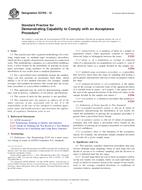Potrebujeme váš súhlas na využitie jednotlivých dát, aby sa vám okrem iného mohli ukazovať informácie týkajúce sa vašich záujmov. Súhlas udelíte kliknutím na tlačidlo „OK“.
ASTM E2334-09(2013)e1
Standard Practice for Setting an Upper Confidence Bound For a Fraction or Number of Non-Conforming items, or a Rate of Occurrence for Non-conformities, Using Attribute Data, When There is a Zero Response in the Sample (Includes all amendments And changes 5/19/2016).
Automaticky preložený názov:
Štandardné praktiky pre stanovenie hornej intervalu spoľahlivosti za zlomok alebo počet nevyhovujúcich kusov, alebo početnosť výskytu u nezhôd, pomocou atribútu dát, kedy je odozva na nulu vo vzorke
NORMA vydaná dňa 1.4.2013
Informácie o norme:
Označenie normy: ASTM E2334-09(2013)e1
Poznámka: NEPLATNÁ
Dátum vydania normy: 1.4.2013
Kód tovaru: NS-45055
Počet strán: 9
Približná hmotnosť: 27 g (0.06 libier)
Krajina: Americká technická norma
Kategória: Technické normy ASTM
Kategórie - podobné normy:
Anotácia textu normy ASTM E2334-09(2013)e1 :
Keywords:
attribute, confidence coefficient, defect, defective, non-conforming item, non-conformity, zero response, ICS Number Code 03.120.30 (Application of statistical methods)
Doplňujúce informácie
| Significance and Use | ||||||||||||||
|
4.1 In Case 1, the sample is selected from a process or a very large population of interest. The population is essentially unlimited, and each item either has or has not the defined attribute. The population (process) has an unknown fraction of items p (long run average process non-conforming) having the attribute. The sample is a group of 4.2 In Case 2, a sample of 4.3 In Case 3, there is a process, but the output is a continuum, such as area (for example, a roll of paper or other material, a field of crop), volume (for example, a volume of liquid or gas), or time (for example, hours, days, quarterly, etc.) The sample size is defined as that portion of the “continuum” sampled, and the defined attribute may occur any number of times over the sampled portion. There is an unknown average rate of occurrence, λ, for the defined attribute over the sampled interval of the continuum that is of interest. The sample does not exhibit the attribute. For a roll of paper this might be blemishes per 100 ft2; for a volume of liquid, microbes per cubic litre; for a field of crop, spores per acre; for a time interval, calls per hour, customers per day or accidents per quarter. The rate, λ, is proportional to the size of the interval of interest. Thus, if λ = 12 blemishes per 100 ft2 of paper, this is equivalent to 1.2 blemishes per 10 ft2 or 30 blemishes per 250 ft2. It is important to keep in mind the size of the interval in the analysis and interpretation. The objective is to determine an upper confidence bound, λu, for the unknown occurrence rate λ, whereby one can claim that λ ≤λu with some confidence coefficient (probability) C. The Poisson distribution is the sampling distribution in this case. 4.4 A variation on Case 3 is the situation where the sampled “interval” is really a group of discrete items, and the defined attribute may occur any number of times within an item. This might be the case where the continuum is a process producing discrete items such as metal parts, and the attribute is defined as a scratch. Any number of scratches could occur on any single item. In such a case the occurrence rate, λ, might be defined as scratches per 1000 parts or some similar metric. 4.5 In each case a sample of items or a portion of a continuum is examined for the presence of a defined attribute, and the attribute is not observed (that is, a zero response). The objective is to determine an upper confidence bound for either an unknown proportion, p (Case 1), an unknown quantity, D (Case 2), or an unknown rate of occurrence, λ (Case 3). In this standard, confidence means the probability that the unknown parameter is not more than the upper bound. More generally, these methods determine a relationship among sample size, confidence and the upper confidence bound. They can be used to determine the sample size required to demonstrate a specific p, D or λ with some degree of confidence. They can also be used to determine the degree of confidence achieved in demonstrating a specified p, D or λ. 4.6 In this standard allowance is made for misclassification error but only when misclassification rates are well understood or known, and can be approximated numerically. 4.7 It is possible to impose the language of classical acceptance sampling theory on this method. Terms such as Lot Tolerance Percent Defective, Acceptable Quality Level, Consumer Quality Level are not used in this standard. For more information on these terms, see Practice E1994. |
||||||||||||||
| 1. Scope | ||||||||||||||
|
1.1 This practice presents methodology for the setting of an upper confidence bound regarding a unknown fraction or quantity non-conforming, or a rate of occurrence for nonconformities, in cases where the method of attributes is used and there is a zero response in a sample. Three cases are considered. 1.1.1 The sample is selected from a process or a very large population of discrete items, and the number of non-conforming items in the sample is zero. 1.1.2 A sample of items is selected at random from a finite lot of discrete items, and the number of non-conforming items in the sample is zero. 1.1.3 The sample is a portion of a continuum (time, space, volume, area etc.) and the number of non-conformities in the sample is zero. 1.2 Allowance is made for misclassification error in this standard, but only when misclassification rates are well understood or known and can be approximated numerically. |
||||||||||||||
| 2. Referenced Documents | ||||||||||||||
|
Podobné normy:
Historická
1.6.2012
Historická
1.10.2013
Historická
1.12.2012
Historická
1.11.2012
Historická
1.10.2011
Historická
1.5.2011



 ASTM E2093-12
ASTM E2093-12 ASTM E2586-13
ASTM E2586-13 ASTM E2587-12
ASTM E2587-12 ASTM E2709-12
ASTM E2709-12 ASTM E2810-11e2
ASTM E2810-11e2 ASTM E2819-11
ASTM E2819-11
 Cookies
Cookies
